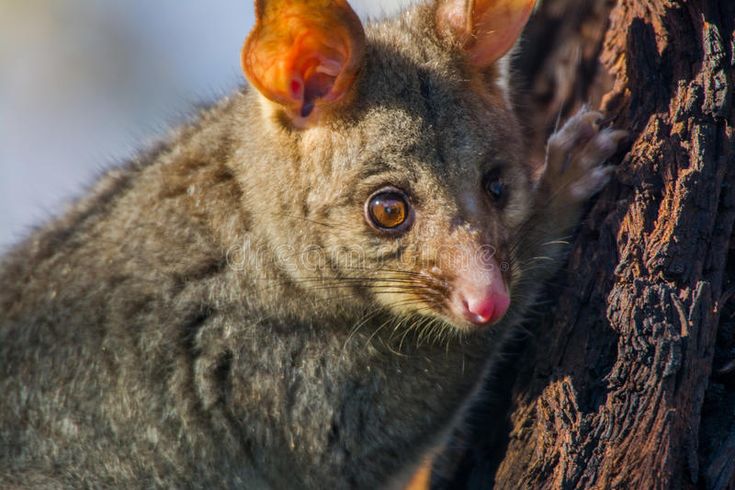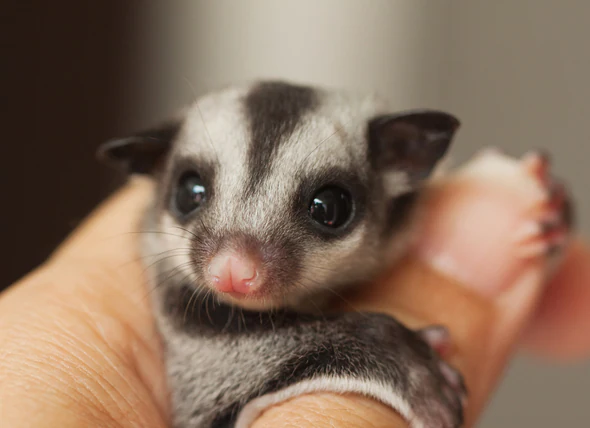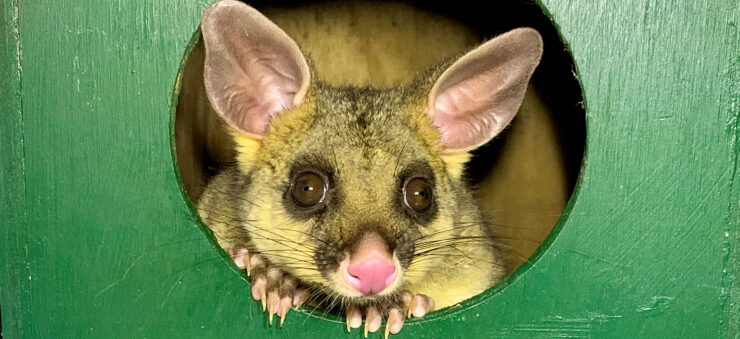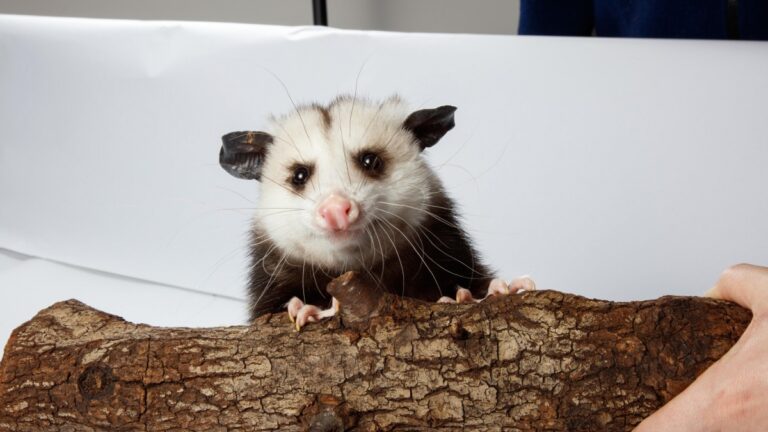The sugar glider or marsupial flying squirrels are native to the northern and eastern regions of Australia, in New Guinea, Tasmania, and on the islands of the Bismarck Archipelago. They are arboreal marsupial mammals, the smallest and most common species of possums. They got their name because of their ability to float through the air and their love of sweets.
The weight of the possum depends on its gender and ranges from ninety to one hundred and sixty grams. They have thin, slightly elongated bodies and adult animals reach about forty-two centimeters in length, of which about half falls on their fluffy tails. The coat of possums is usually gray, but some animals have yellow or yellow-brown fur. Sugar gliders have brown stripes on their backs; their bellies are usually white. They have small, slightly pointed muzzles and large ears, able to turn in different ways to catch any sounds. Their large black eyes help them see perfectly in the dark. Sugar gliders have five long thin fingers on each paw with sharp claws to get larvae and small insects from under the bark.
The distinguishing feature of sugar gliders is a thin leather membrane that stretches along the sides of their bodies, wrist to ankle. It stretches with a sugar glider jumps, thus forming an aerodynamic surface. This way, sugar gliders are able to plan for a distance of up to fifty meters. They can change the direction of the flight by relaxing or pulling the membrane, along with steering with the legs and tail. Males mark the territory with glands located on their chests, forehead, and back. Unlike females species, males have a small bald spot on their foreheads, where the glands are located. Females have a bag in the center of the abdomen to carry their offspring.
Habitat

Sugar gliders spend most of their time in trees and very rarely come to the ground. Their usual habitat is eucalyptus forests. They are nocturnal animals, and during the day they sleep in tree hollows or other places they chose for shelter. Sugar gliders live in small groups that hold up to seven adults and babies during the breeding season. The dominant male marks the territory and his tribe members with secretions from his glands. Strangers with different smells are expelled from the territory.
1. Sugar gliders don’t like the cold, so their activity is limited in rainy or cold weather. In winter they become inactive and sluggish and then hibernate. In nature, sugar gliders feed on spiders and insects, birds and small animals, and the juice of local trees.
Keeping sugar gliders at home is not an easy task but is still possible. To provide a sugar glider with the best care, you should stick to the following rules.
2. Sugar glider won’t adapt to its owner’s daily routine, instead will behave as it’s used to. Since they are nocturnal animals, they will jump around the cage, make various sounds, and rattle the bars. Therefore, it is best to have a separate room for the cage, preferably located away from the bedroom.
3. Sugar gliders are not very clean and don’t know how to use the toilet. In nature, they urinate in the air when they jump from tree to tree, without falling to the ground. So at home, they will mark furniture, wallpaper, and even the owner with their excrement. They are also used to mark their territory with special glands that produce a very specific smell. It is almost impossible to get rid of entirely, so you will have to make your peace with it.
4. Under no circumstance you should entrust a sugar glider to a child, for the sake of both the child and the animal. Sugar gliders will bite hard if a child will squeeze them too hard. They also like to run around the owner like a tree and may leave deep wounds with their claws that heal poorly.

But, despite all the cons of keeping sugar gliders at home, there are more pros to it. Conditions of keeping sugar possum at home require maximum space. You should keep in mind that sugar gliders are very active and are used to living on the trees. It is better to keep them in spacious cages with a distance between the bars of about 1.3 cm. The rods must have a PVC coating.
These animals are very smart, so you need to get a secure lock. There should be a drinking bowl and several feeders in the cage. Before you hang up the drinking bowl, you should make sure that your pet is familiar with it. Otherwise, your sugar glider may simply die of thirst. Feeders should be metal or ceramic, small in size. Climbing devices should be built inside the cage. Branches, pipes for rodents, ladders, or ropes are suitable for sugar gliders. It’s necessary to provide a house within the cage. It can be made of wood or fabric. The passage to the house should be from seven to nine centimeters in diameter.
If you have a couple of animals, then they might produce offspring. In this case, the house will have to be lowered so that the kids do not fall. Since possums mark the territory, the cage and its contents will have to be washed often. At the same time, you need to be very careful with detergents. Everything should be rinsed well. You cannot let the animals freely roam in a house where other animals or birds of prey live. You should keep in mind that possums do not like drafts, temperatures below twenty degrees, and bright lighting.
In the dwelling

Fruit is the most important product in the glider’s diet. They should make up 70% of the serving. Protein food should make up 30% of the serving. There should be less phosphorus and more calcium in the food. You can give something sweet in small quantities, as a treat. You can give them small pieces of meat (unsalted boiled chicken or turkey meat). Once a week, it’s best to give your pets honey, which positively affects digestion.
In the dwelling of the sugar glider, it is necessary to place:
● a running wheel;
● lianas;
● branches and driftwood;
● ropes (climbing ropes) and a rope ladder;
● toys for active rodents;
● a hollow or its imitation is a place of sleep.
It is advisable to place several shelters because the animals like to sleep in several places. To provide the pet with optimal physical activity, you should acquire a necessary cage with a total area of at least three sq. m. If the cage is smaller, the sugar glider can stay in it only for a short time. The good news is that sugar gliders are very disciplined, they learn quickly, and they can be released into the home.
Flying squirrels are very active. If you decide to keep a glider at home, you need to acquire a spacious cage. The minimum size of the cage for keeping the animal should be 80x80x60. But the higher the cage, the more comfortable your pet will be. The distance between the bars should not exceed 1.5 cm, otherwise, the pet may squeeze between the bars and even fall out. The door to the cage must be equipped with a strong lock. Sugar gliders are very inventive animals, and they easily learn to open an unfixed passage.
The floor of the cage should be covered with a special filler designed for rodents (pressed sawdust). Sugar gliders must have branches in their cage. After all, as already mentioned, these animals spend most of their time in trees in their natural habitat. Climbing trees is inherent in nature in these pets.
Bowls for food and water should be placed in different parts of the enclosure. This will keep the water clean for as long as possible. A mandatory attribute of the glider’s place of residence is a house. Ideally, it should be a suspended structure that should be fixed as high as possible. Wooden or plywood boxes can be used for the house, and a soft knitted pocket is also suitable. Sugar gliders are very fond of soft nests. If the frame of the house is hard, be sure to lay hay in it or put soft rags. Ladders, tunnels, special wheels for running, mirrors, bells, and small balls will be suitable as toys and entertainment for the flyers. Be sure to update the toys so that the animal does not lose interest in them.
Read more on: https://recommend24.com/category/pet-supplies/







